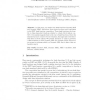Free Online Productivity Tools
i2Speak
i2Symbol
i2OCR
iTex2Img
iWeb2Print
iWeb2Shot
i2Type
iPdf2Split
iPdf2Merge
i2Bopomofo
i2Arabic
i2Style
i2Image
i2PDF
iLatex2Rtf
Sci2ools
SACRYPT
2009
Springer
2009
Springer
Cryptanalysis of Dynamic SHA(2)
In this paper, we analyze the hash functions Dynamic SHA and Dynamic SHA2, which have been selected as first round candidates in the NIST hash function competition. These hash functions rely heavily on data-dependent rotations, similar to certain block ciphers, e.g., RC5. Our analysis suggests that in the case of hash functions, where the attacker has more control over the rotations, this approach is less favorable than in block ciphers. We present practical, or close to practical, collision attacks on both Dynamic SHA and Dynamic SHA2. Moreover, we present a preimage attack on Dynamic SHA that is faster than exhaustive search. Key words: Dynamic SHA, Dynamic SHA2, SHA-3 candidate, hash function, collision attack.
| Added | 27 May 2010 |
| Updated | 27 May 2010 |
| Type | Conference |
| Year | 2009 |
| Where | SACRYPT |
| Authors | Jean-Philippe Aumasson, Orr Dunkelman, Sebastiaan Indesteege, Bart Preneel |
Comments (0)

